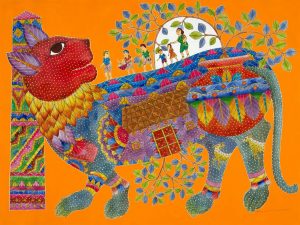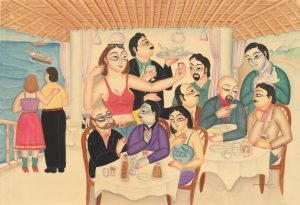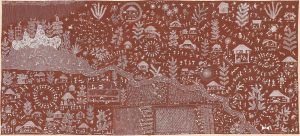
The world of the Gonds 2017; Bhopal, Madhya Pradesh; synthetic polymer paint on canvas
125.0 x 91.0 cm; National Gallery of Victoria, Melbourne; Purchased NGV Foundation, 2019
© Venkat Shyam, courtesy of Minhazz Majumdar

MELBOURNE, 8 April 2022: Celebrating the unique artistic traditions developed by diverse indigenous and regional communities across India, Transforming Worlds: Change and Tradition in Contemporary India explores the ways in which artists and creatives are using these visual languages to respond to India’s rapidly changing social environment, including changing gender dynamics and the recent COVID-19 pandemic.
Drawn entirely from the NGV Collection, the exhibition showcases an important new collecting focus resulting in more than sixty recent acquisitions that have never-before been displayed. The presentation features dynamic and thought-provoking works by established and emerging artists from distinct communities across India, including the Gond and Warli painters of central India; the
Suthar, Jogi, Santal and Madhubani artists of northern India; and the Kalighat and Chitrakar painters of eastern India. Many featured artists share long intergenerational lineages with artist families and communities central to the development of Indian vernacular movements and styles that have gained international recognition in recent years.
Illuminating a range of current experiences from local perspectives – including urbanisation, environmental degradation, shifting gender dynamics and public health issues including the COVID-19 pandemic – the exhibition reveals the emergence of increasingly socially and politically engaged art practices within regional communities. The exhibition also highlights the ways in which artistic traditions have been strengthened and retained by engaging with contemporary themes.
Highlights include large-scale contemporary examples of patachitra (picture cloth), storytelling scrolls up to five metres in length that were traditionally used by travelling performers in Odisha and West Bengal who sang accompanying stories as they were unrolled. Customarily depicting narratives of mythological epics and local folklore, artists are increasingly using the vibrantly coloured scrolls to depict contemporary events. Emerging patachitra artist Sonia Chitrakar uses the scroll format to document the introduction and spread of COVID-19 throughout India in COVID scroll 2020. In another response to the pandemic, artist Apindra Swain’s paintings Wash hands 2020 and Stay home 2020 use traditional iconography and visual messaging to create community education tools promoting COVID-safe practices.
The exhibition also features a major recent painting by Rajesh Chaitya Vangad, a third-generation painter of the Warli tribe, one of western India’s largest indigenous groups. Based in artistic traditions traced back to the 10th century CE, Warli paintings depicting daily life and rituals were traditionally rendered as rice paste murals on the internal walls of homes. Vangad’s work represents the artform’s transition to canvas and paint in recent decades: The natural world of Warlis 2017 uses the distinctive Warli pictorial language to illustrate the traditional lifestyle of his community, including the strong and harmonious connection to the land that is increasingly challenged by urbanisation and environmental degradation.

A further highlight is the intricate drawings of the Jogi family, who first developed their distinctive style of art during the 1970s to depict narratives they had traditionally told through devotional songs. Today this style of ink drawing on paper is renowned for its extremely fine, detailed line-work and is exclusively practised by three generations of the Jogi family in Ahmedabad, Gujarat. The exhibition will feature recent drawings by members of the family including three generations of Jogi women, representing subjects of worship and natural history, scenes of urban development, and contemporary social and gender dynamics.
Tony Ellwood AM, Director of the National Gallery of Victoria, said: ‘India is home to many distinct indigenous and regional communities renowned for having developed unique artistic styles that incorporate specialised materials and techniques. With many of the works on display having been created in the last three years and in response
to pressing local and international events, some of which are still ongoing, this exhibition is a timely celebration of the continuing relevance of centuries-old artistic traditions.’

Transforming Worlds: Change and Tradition in Contemporary India will be on display from 9 April to 28 August 2022 at NGV International, St Kilda Road, Melbourne. Entry is FREE. Further information is available via the NGV website.



